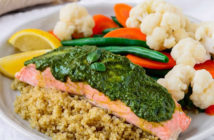All of us know intake of fresh fruits and vegetables are the key to stay healthy. Yet, most of us struggle to get through the standard five servings of vegetables and fruits daily. If you too belong to this league, get ready for some tougher news. The US Department of Health And Human Services, as well as Department of Agriculture, released new dietary guidelines last year that recommend nine servings daily, which mean consuming about 2.5 cups of vegetables and 2 cups of fruits every day. From people who don’t like eating fruits and veggies to those with bad childhood experiences with fruits and veggies that influence their present feelings toward these foods, getting nine servings may seem like an impossible task. Yet, for your health, this is important.
According to the spokeswoman for PBH (Produce for Better Health Foundation) Christine Filardo (MS, RD), the country’s best nutrition minds have arrived at these dietary recommendations after their careful study of the research depicting the benefits of fruits and vegetables in decreasing the risk for type 2 diabetes, heart disease, high blood pressure and certain cancers. Fighting the obesity epidemic can also become easier by having vegetables and fruits on your plate. Filardo added that the key reasons for staying away from consuming more fruits and vegetables are due to people not being aware of how to rustle up quick, healthy recipes, or the inconvenience factor.
Does it mean you can’t develop the 9-servings a day habit? Experts say you can, provided you do these:
- Remind yourself consistently to eat vegetables and fruits.
- Opt for veggies and fruits anywhere you go – from home and office to parties, restaurants or other events you attend.
- Make buying and meal preparations easy so that they don’t interfere with your busy schedule.
- Start small – perhaps with just 1 serving daily, to begin with, provided you don’t have the habit of eating fruits and veggies. Slowly, increase your servings and stick to the plan of taking it to 9.
If this still sounds difficult, we bring you 19 guaranteed ways to help you eat and enjoy nine servings of fruits and vegetables every day.
-
Rustle up a fruit salad
 Instead of whole fruits that often don’t appeal much, make fruit salads after washing and cutting the fresh fruits. Every week, take a look at your produce bin a few times to make a fruit salad. The colourful platter will surely tempt you.
Instead of whole fruits that often don’t appeal much, make fruit salads after washing and cutting the fresh fruits. Every week, take a look at your produce bin a few times to make a fruit salad. The colourful platter will surely tempt you.
-
Keep the fruits stacked in a bowl on your dining table/office desk
 Set a big bowl of colourful fruits as part of your interior décor. You will soon find yourself munching on these healthy snacks whenever you pass by, are on the phone, or simply bored and have a hungry stomach to satisfy.
Set a big bowl of colourful fruits as part of your interior décor. You will soon find yourself munching on these healthy snacks whenever you pass by, are on the phone, or simply bored and have a hungry stomach to satisfy.
-
Make your breakfast including some fruits
 Whether you are having cereals (hot/cold), French toast, pancakes or a smoothie in your breakfast, make sure to add some fresh, dried or frozen fruits to them.
Whether you are having cereals (hot/cold), French toast, pancakes or a smoothie in your breakfast, make sure to add some fresh, dried or frozen fruits to them.
-
Give your recipes a twist by adding some veggies
 Whether you are making an omelette or a potato skillet dish, toss in some chopped onions, tomatoes, mushrooms, broccoli florets, chilli peppers, green peppers, or any other vegetable available at your fingertips.
Whether you are making an omelette or a potato skillet dish, toss in some chopped onions, tomatoes, mushrooms, broccoli florets, chilli peppers, green peppers, or any other vegetable available at your fingertips.
-
Make green salad an integral part of your meals
 Be it your lunch, evening snack, or dinner, eating a green salad every day is a delicious way to work veggies into your meals. Add as many raw vegetables you can lay your hand on – from grated carrots, cucumber, tomato and onion to zucchini, green beans, jicama, broccoli florets, radishes and more. Replace iceberg lettuce with nutrient-rich raw spinach or romaine. To satiate your sweet tooth, add some fruits like grapes, strawberries, mango, pears, papaya and orange segments to your green salad.
Be it your lunch, evening snack, or dinner, eating a green salad every day is a delicious way to work veggies into your meals. Add as many raw vegetables you can lay your hand on – from grated carrots, cucumber, tomato and onion to zucchini, green beans, jicama, broccoli florets, radishes and more. Replace iceberg lettuce with nutrient-rich raw spinach or romaine. To satiate your sweet tooth, add some fruits like grapes, strawberries, mango, pears, papaya and orange segments to your green salad.
-
Pair cheese with fruit
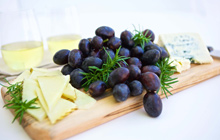 Some fruits like apples, pears, and grapes are great for such pairings, which you can have as a snack, dessert, or even carry them when having a picnic.
Some fruits like apples, pears, and grapes are great for such pairings, which you can have as a snack, dessert, or even carry them when having a picnic.
-
Snack on dried fruits
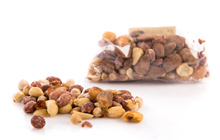 If you need healthy snacks, dried fruits are your best bet since they don’t go bruised or bad. They are portable, making you carry them easily in your bag, or even store in your desk. Stay much on dried pears, cherries, apricots, peaches, blueberries, prunes, nectarines, raisins, dates and more anytime you are hungry.
If you need healthy snacks, dried fruits are your best bet since they don’t go bruised or bad. They are portable, making you carry them easily in your bag, or even store in your desk. Stay much on dried pears, cherries, apricots, peaches, blueberries, prunes, nectarines, raisins, dates and more anytime you are hungry.
-
Make a win-win combo by adding your favourite veggies to your most loved dishes
 If you love spaghetti, load your spaghetti sauce up with finely chopped pieces of your favourite veggies like mushroom, zucchini, yellow squash, eggplant, and onions. In a similar way, you can supplement some of your favourite dishes with veggies that complement the taste like adding some chopped vegetables to your omelette, packing some veggies into a cheese quesadilla, or stirring broccoli florets into cheese and macaroni.
If you love spaghetti, load your spaghetti sauce up with finely chopped pieces of your favourite veggies like mushroom, zucchini, yellow squash, eggplant, and onions. In a similar way, you can supplement some of your favourite dishes with veggies that complement the taste like adding some chopped vegetables to your omelette, packing some veggies into a cheese quesadilla, or stirring broccoli florets into cheese and macaroni.
-
Have some soup
 Include vegetable soups when having a snack or eating at a restaurant or home. Even when having canned soups, you can add some vegetables to it by stirring them in while you are cooking or heating the soup.
Include vegetable soups when having a snack or eating at a restaurant or home. Even when having canned soups, you can add some vegetables to it by stirring them in while you are cooking or heating the soup.
-
Drink it up (your fruits and veggies)
 Some people prefer drinking their veggies and fruits. If you too belong to this league, try blending some fruit juice (like tangerine or orange juice) with carrot juice or V-8, which equals one serving of vegetables. Drinking it up would mean you have got a vegetable and a fruit serving.
Some people prefer drinking their veggies and fruits. If you too belong to this league, try blending some fruit juice (like tangerine or orange juice) with carrot juice or V-8, which equals one serving of vegetables. Drinking it up would mean you have got a vegetable and a fruit serving.
-
Top up your pizza with veggies
 Pizza lovers can try putting some vegetables atop their pizza like a combination of onion, tomato, zucchini, bell pepper, artichoke hearts and mushroom.
Pizza lovers can try putting some vegetables atop their pizza like a combination of onion, tomato, zucchini, bell pepper, artichoke hearts and mushroom.
-
Grill your fruits and veggies
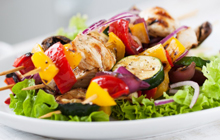 Once you have finished grilling your meat or fish, throw some veggies and/or fruits on the grill to ensure the hot coals are put to good use. You won’t believe how good your grilled veggies and/or fruits would taste. You may even marinate them with the same marinade you use for your meat, though separately to ensure your fruits and/or veggies don’t come in contact with raw meat juices).
Once you have finished grilling your meat or fish, throw some veggies and/or fruits on the grill to ensure the hot coals are put to good use. You won’t believe how good your grilled veggies and/or fruits would taste. You may even marinate them with the same marinade you use for your meat, though separately to ensure your fruits and/or veggies don’t come in contact with raw meat juices).
Preparing a vegetable kabob with pieces of various vegetables (carrot, eggplant, bell pepper, zucchini mushrooms etc) is a good way to have your veggie serving. While you won’t need to precook soft vegetables, it would help to steam cook or run them in the microwave when you are handling firm vegetables like carrots, sweet potatoes, or broccoli, before throwing them on the grill.
-
Shop for them at fast-food chains
 You can buy your vegetables at many drive-throughs and fast-food chains, provided you are looking for salads. For example, at Wendy’s, you can get a 35-calorie side salad (with 0 grams fat, excluding dressing) or a 70-calorie Caesar side salad (with 4 grams of fat, excluding dressing). Opt for low-fat honey mustard, fat-free French, or creamy ranch dressing with reduced fat. By consuming half the packet, you will get almost 50 calories and anywhere from 0 to 4 grams of fat, depending on your choice of dressing.
You can buy your vegetables at many drive-throughs and fast-food chains, provided you are looking for salads. For example, at Wendy’s, you can get a 35-calorie side salad (with 0 grams fat, excluding dressing) or a 70-calorie Caesar side salad (with 4 grams of fat, excluding dressing). Opt for low-fat honey mustard, fat-free French, or creamy ranch dressing with reduced fat. By consuming half the packet, you will get almost 50 calories and anywhere from 0 to 4 grams of fat, depending on your choice of dressing.
-
Have a fruity dinner platter
 Learn a simple trick from restaurants of garnishing your dinner plate with fruits to make your meal look more colourful and inviting. From placing a wedge of melon to adding a sliced kiwi, some grapes, an orange wheel, be creative to add texture, fun and colour to your dinner platter.
Learn a simple trick from restaurants of garnishing your dinner plate with fruits to make your meal look more colourful and inviting. From placing a wedge of melon to adding a sliced kiwi, some grapes, an orange wheel, be creative to add texture, fun and colour to your dinner platter.
-
Put cheese sauce to change the game
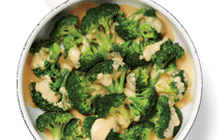 A pile of cauliflower or broccoli spears may not appear tempting but put some grated cheese or pour some cheese sauce atop and you will feel the change. To make a lower-fat cheese sauce, you can use fat-free half-and-half, reduced-fat cheese, no margarine or butter.
A pile of cauliflower or broccoli spears may not appear tempting but put some grated cheese or pour some cheese sauce atop and you will feel the change. To make a lower-fat cheese sauce, you can use fat-free half-and-half, reduced-fat cheese, no margarine or butter.
-
Eat raw veggies
 At times, raw vegetables may be more appealing than their cooked avatars. When you are ready to eat your plate of assorted raw veggies by dipping them in some lip-smacking low-fat dip, you not even notice the veggies! You can try some raw broccoli florets, cauliflower, spinach or cabbage, together with the usual celery and carrots. Pair them up with an Italian or a light ranch dressing as a dip. You may even make your own dip and put it in the refrigerator to make it ready to be used.
At times, raw vegetables may be more appealing than their cooked avatars. When you are ready to eat your plate of assorted raw veggies by dipping them in some lip-smacking low-fat dip, you not even notice the veggies! You can try some raw broccoli florets, cauliflower, spinach or cabbage, together with the usual celery and carrots. Pair them up with an Italian or a light ranch dressing as a dip. You may even make your own dip and put it in the refrigerator to make it ready to be used.
-
Serve the most perishable items first
 As soon as you return from your grocery shopping trip, serve the most perishable items at first, while saving the hardier ones for later. So, strawberries need to be served today, oranges soon after that, followed by grapes and bananas the next day, while mangoes and apples can be put on the platter on day 3.
As soon as you return from your grocery shopping trip, serve the most perishable items at first, while saving the hardier ones for later. So, strawberries need to be served today, oranges soon after that, followed by grapes and bananas the next day, while mangoes and apples can be put on the platter on day 3.
-
Stock your fridge with ready to eat fruits and veggies
 After you have shopped for fruits, wash them and put some out for instant eating. The rest can be stored in plastic containers or bags inside the refrigerator. This way, you and your family, when hungry, can munch on them instead of looking for unhealthy snacks.
After you have shopped for fruits, wash them and put some out for instant eating. The rest can be stored in plastic containers or bags inside the refrigerator. This way, you and your family, when hungry, can munch on them instead of looking for unhealthy snacks.
-
Use a little salt
 Use lightly salted water to boil your fresh vegetables since this is an easy flavour enhancement trick that many people aren’t even aware of. This simple step can make you love the broccoli a little instead of running away from it.
Use lightly salted water to boil your fresh vegetables since this is an easy flavour enhancement trick that many people aren’t even aware of. This simple step can make you love the broccoli a little instead of running away from it.
Try these simple Recipes:
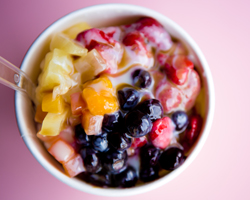
1) 50/50 Fruit Dip (or Fruit Salad)
Note as: 2 medium chunks of fresh fruit
You will need:
- 1.5 cups of low-fat milk
- 1 package (approx 1.4 ounces) fat-free and sugar-free instant vanilla pudding mix
- Half a cup of fat-free sour cream
- 5 tablespoons of thawed orange juice concentrate (frozen)
- 2 sliced bananas
- 2 cups melon balls or cubes (cantaloupe, honeydew, watermelon, etc.)
- 2 peeled oranges, broken down into segments
- 2 apples, cored and sliced
- 2 pears or nectarines, peaches, cored and sliced
Instructions:
Use a mixing bowl to blend milk, pudding mix and orange juice concentrate by beating the ingredients for 2 minutes at medium speed. Mix/beat in sour cream. Use all fruits to rustle up a dressed fruit salad, atop which you pour the orange dressing and make it bend with a gentle toss. Else, serve your orange dip with the fruit platter you have prepared. Serve immediately, or refrigerate it (after having it covered) until it’s ready to be served.
– You get 8 to 10 cups of fruit salad.
For each cup of fruit salad and dip (taking it to be 8 cups per recipe):162 calories, 37 g carbohydrate, 4 g protein, 1 g fat, 0.4 g saturated fat, 2 mg cholesterol, 35 mg sodium, 3.5 g fibre. 6% calories from fat.

2) Tropical Fruit Salad
Note as: 1 fruit (medium piece) + 0.5 cups of canned fruit in juice
You will need:
- 20-ounce can of pineapple pieces
- 2 cups of strawberries, each fruit cut in 4 pieces
- 1 big banana (sliced)
- 2 peeled kiwi, cut into halves and sliced
- 0.5 teaspoon of finely grated lime peel or zest
- 1 mango or papaya, peeled and cubed (you may even use an 11-ounce can of mandarin oranges, that have been drained)
- 2 tablespoons lime juice
- 1.5 tablespoons of honey
- 1/3 cup of sweetened or unsweetened shredded coconut (optional)
Instructions:
Drain pineapple chunks, and set aside a quarter cup of the pineapple juice.
Add kiwi, pineapple chunks, strawberries, papaya or mango, and banana to a big serving bowl.
Put a quarter cup of pineapple juice, honey, lime juice and lime peel in a 2-cup measure and blend nicely by whisking. Drizzle atop the salad and let the fruits get coated well by tossing it lightly. Before serving, sprinkle coconut on the top, if needed.
– You get Almost 7 cups.
Each cup: 101 calories, 25 g carbohydrate, 1.2 g protein, 0 g saturated fat, 0.6 g fat, 0 mg cholesterol, 4 mg sodium, 3 g fibre. 5% calories from fat.

3) Vegetable Garlic Sauté
Note as: 0.5 cup vegetables with 1 teaspoon fat + 0.5 cups of vegetables sans added fat
You will need:
- You can replace any vegetable listed below with the ones you like.
- 2.5 cups of Brussels sprouts (from which you have removed the loose outer leaves and sliced them in half – almost 0.5 pound)
- 1 large (or 2 small) tomatoes, diced
- 2.5 cups of yellow squash or zucchini, which you have cut into quarter inch slices (measuring almost 0.5 pounds)
- 1 teaspoon crushed garlic
- 4 teaspoons of olive oil (extra virgin)
- 1 tablespoon grated or shredded Parmesan cheese
Instructions:
In a microwave-safe dish, put squash, Brussels sprouts, and a few tablespoons of water. Run the microwave on HIGH to cook the vegetables lightly. Drain well.
Take a large skillet or nonstick frying pan, add oil and garlic to it, and heat for 1-2 minutes on medium heat. Stir in the squash, Brussels sprouts and tomato. Sauté them for a few minutes, or until the vegetables become tender to the degree you want them to. Before serving, sprinkle Parmesan cheese atop.
– You get 4 servings.
Each serving: 94 calories, 11 g carbohydrate, 4 g protein, 0.8 g saturated fat, 5 g fat, 26 mg sodium, 0.6 mg cholesterol, 5 g fibre. 44% calories from fat.




